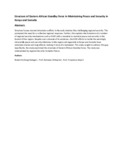| dc.contributor.author | Kabage, Robert Gichangi | |
| dc.contributor.author | Onkware, Kennedy | |
| dc.contributor.author | Iteyo, Crispinous | |
| dc.date.accessioned | 2021-12-14T13:16:07Z | |
| dc.date.available | 2021-12-14T13:16:07Z | |
| dc.date.issued | 2020-12 | |
| dc.identifier.uri | https://www.ijrrjournal.com/IJRR_Vol.7_Issue.11_Nov2020/IJRR0061.pdf | |
| dc.identifier.uri | http://ir-library.mmust.ac.ke:8080/xmlui/handle/123456789/1835 | |
| dc.description.abstract | Structural issues marred intrastate conflicts in
the early nineties thus challenging regional
security. This prompted the need for a collective
regional response. Further, this explains the
formation of a number of regional security
mechanisms such as EASF with a mandate to
maintain peace and security in the Eastern
Africa region. Despite over a decade of its
existence, the EASF efforts to tackle the
seemingly intractable peace and security
dilemmas in the region and especially in Kenya
and Somalia have remained elusive and
insignificant, making it more of a bystander.
This study sought to address this gap.
Specifically, the study examined the structure of
Eastern African Standby Force. The study was
underpinned by regional Security Complex
theory. | en_US |
| dc.language.iso | en | en_US |
| dc.subject | Structure, Eastern, African, Standby, Force,Maintaining, Peace, Security, Kenya , Somalia | en_US |
| dc.title | Structure of Eastern African Standby Force in Maintaining Peace and Security in Kenya and Somalia | en_US |
| dc.type | Article | en_US |

